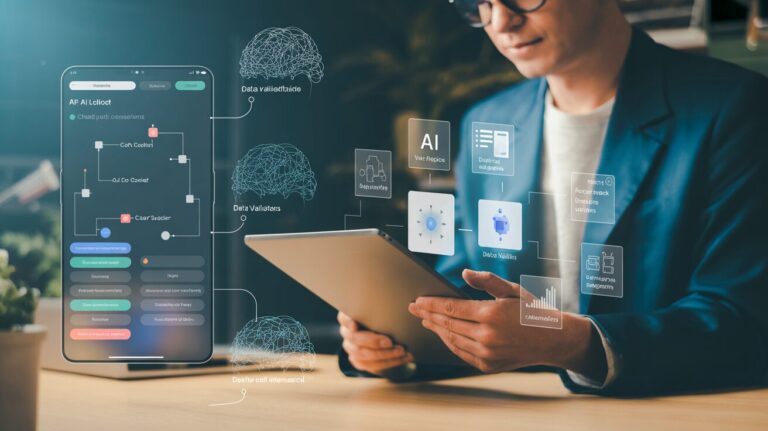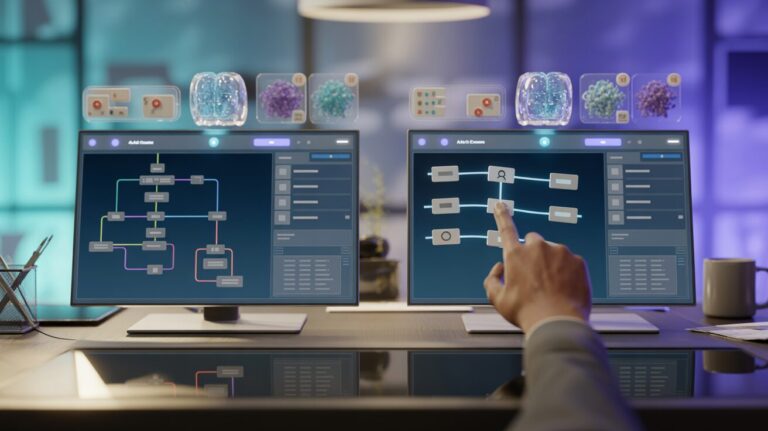Table Of Contents
- Understanding Zero-Trust Architecture
- Why Zero-Trust Matters for No-Code AI
- Core Components of Zero-Trust for No-Code Platforms
- Implementing Zero-Trust in Your No-Code AI Applications
- Common Security Challenges and Solutions
- Future of Security in No-Code AI
- Conclusion
The democratization of artificial intelligence through no-code platforms has opened up unprecedented opportunities for innovation across industries. As professionals without technical backgrounds gain the ability to create sophisticated AI applications, a critical question emerges: How can these powerful tools be secured without sacrificing the accessibility that makes them revolutionary?
Enter zero-trust architecture—a security framework that’s becoming essential in the no-code AI landscape. Unlike traditional security models that automatically trust users within a network, zero-trust follows a simple principle: “never trust, always verify.” This approach is particularly vital for no-code AI platforms where the barrier to creating powerful applications has been dramatically lowered.
In this comprehensive guide, we’ll explore how zero-trust architecture applies specifically to no-code AI development, why it matters for your custom applications, and practical ways to implement these security principles—even if you have no technical background in cybersecurity.
Zero-Trust Architecture for No-Code AI
Securing Your Custom AI Applications Without Sacrificing Simplicity
The Zero-Trust Difference
Unlike traditional “castle and moat” security that trusts users inside a network, zero-trust follows the principle: “never trust, always verify” – perfect for no-code AI platforms where access control is critical.
Why It Matters
No-code AI platforms democratize AI creation while handling sensitive data. Zero-trust security protects intellectual property and ensures compliance without requiring users to understand complex security implementations.
Core Principles of Zero-Trust Security
1. Verify Explicitly
Authentication based on all available data points: identity, location, device health, and service.
2. Least Privilege Access
Users receive minimum access needed for their tasks, limiting potential damage from breaches.
3. Assume Breach
Security systems operate assuming a breach has occurred, minimizing potential damage through segmentation.
Technical Components of Zero-Trust in No-Code AI
Identity Verification
- Multi-factor authentication
- Continuous session validation
- Role-based access control
Micro-segmentation
- Separate dev/production environments
- Application isolation
- Data compartmentalization
End-to-End Encryption
- Data in transit protection
- Data at rest security
- AI model parameter protection
How To Implement Zero-Trust in Your No-Code AI Apps
Security-First Design
Collect only essential data and clearly define application scope and access requirements from the start.
User Authentication
Choose appropriate verification methods and implement role-based access controls for your application.
Regular Assessment
Conduct periodic access audits, test application logic, and monitor for unusual usage patterns.
Future-Proof Your No-Code AI Applications
Estha’s platform includes zero-trust architecture by design, allowing you to focus on innovation while ensuring security compliance.
Understanding Zero-Trust Architecture
Zero-trust architecture represents a fundamental shift in how we approach security. Traditional security models operated on a “castle and moat” concept—once users were inside the network perimeter, they were largely trusted. Zero-trust, however, operates on the principle that no user, device, or application should be inherently trusted, regardless of their location.
At its core, zero-trust architecture continuously verifies every access request as if it originates from an open network. This verification happens regardless of where the request originates or what resource it’s trying to access. For no-code AI platforms, this means that every interaction with the platform—from building applications to accessing data—requires continuous validation.
Key Principles of Zero-Trust Security
Zero-trust security is built on three fundamental principles that work together to create a comprehensive security framework:
1. Verify explicitly: Authentication and authorization decisions are based on all available data points, including user identity, location, device health, service or workload, data classification, and anomalies.
2. Use least privilege access: Users are given the minimum access needed to complete their tasks. This limits lateral movement within a network if a breach occurs.
3. Assume breach: Security systems operate under the assumption that a breach has already occurred, minimizing blast radius and segmenting access to limit potential damage.
These principles create multiple layers of defense that protect sensitive data and AI models from both external threats and insider risks—a critical consideration as AI applications become more powerful and handle increasingly sensitive information.
Why Zero-Trust Matters for No-Code AI
No-code AI platforms like Estha are democratizing artificial intelligence, allowing educators, healthcare professionals, content creators, and small business owners to build sophisticated AI applications without coding knowledge. This accessibility, however, introduces unique security considerations that zero-trust architecture is uniquely positioned to address.
The Security Paradox of Democratized AI
As AI development becomes more accessible, the security stakes grow higher. No-code platforms must balance two seemingly contradictory goals: maintaining simplicity for non-technical users while implementing robust security measures. Zero-trust architecture helps resolve this paradox by building security into the platform itself rather than requiring users to implement complex security measures.
Consider a healthcare professional building an AI assistant to help patients navigate treatment options. This application may process sensitive patient information that’s subject to strict privacy regulations. With a zero-trust approach, the platform can verify each data access request, ensure proper authentication, and maintain compliance—all without requiring the healthcare professional to understand the underlying security mechanisms.
Protecting Intellectual Property in AI Applications
When professionals build AI applications that embody their unique expertise—whether it’s a financial advisor creating an investment guidance bot or an educator building an interactive quiz system—they’re encoding valuable intellectual property into these applications. Zero-trust architecture helps protect this intellectual property by:
Controlling access to the application’s building blocks: Ensuring only authorized individuals can modify the application structure
Protecting training data: Securing the valuable datasets that inform AI models
Preventing unauthorized duplication: Limiting the ability to copy proprietary AI applications
This protection is essential for professionals who want to monetize their AI creations or maintain a competitive advantage in their industry.
Core Components of Zero-Trust for No-Code Platforms
Implementing zero-trust in a no-code AI environment requires several technical components working together seamlessly. While users don’t need to understand the technical details, knowing these components helps appreciate how platforms like Estha protect your applications and data.
Identity Verification and Management
The foundation of zero-trust security is robust identity verification. No-code AI platforms implement this through:
Multi-factor authentication (MFA): Requiring multiple forms of verification before granting access to the platform or specific applications
Continuous authentication: Constantly verifying user identity throughout sessions, not just at login
Role-based access control: Assigning specific permissions based on a user’s role in the organization
These systems work together to ensure that only authorized users can create, modify, or access AI applications and their underlying data.
Micro-segmentation
Micro-segmentation divides the platform environment into secured zones, each requiring separate authorization. In no-code AI platforms, this might mean:
Separating development environments from production: Ensuring that testing doesn’t affect live applications
Isolating different AI applications from each other: Preventing one application from accessing another’s data
Data compartmentalization: Keeping sensitive data in separate, secured environments
This approach limits the potential damage if any single component is compromised, containing security breaches before they can spread.
End-to-End Encryption
Secure no-code AI platforms implement comprehensive encryption to protect:
Data in transit: Information moving between users and the platform
Data at rest: Stored information in databases and file systems
AI model parameters: The actual “intelligence” behind custom AI applications
Encryption ensures that even if unauthorized access occurs, the data remains unreadable and unusable without the proper decryption keys.
Implementing Zero-Trust in Your No-Code AI Applications
While the no-code platform handles most security aspects, there are practical steps you can take to enhance the security of your AI applications without technical expertise.
Security-First Application Design
When building AI applications on platforms like Estha, consider security from the beginning:
Data minimization: Only collect and process the data you absolutely need for your application to function
Purpose limitation: Clearly define what your AI will do and limit its capabilities to those functions
Access control planning: Determine who needs access to your application and what level of access they require
By incorporating these principles into your application design process, you create a strong foundation for security—even without understanding the technical implementation details.
User Authentication Implementation
When building user-facing AI applications, consider how users will authenticate:
Choose appropriate authentication methods: Determine whether your application requires simple password protection or more robust verification
Implement role-based access: Assign different capabilities to different user types
Consider session management: Decide how long users should remain logged in and under what circumstances they should be automatically logged out
These decisions don’t require coding knowledge but significantly impact the security posture of your application.
Regular Security Assessments
Even no-code applications benefit from regular security reviews:
Conduct periodic access audits: Regularly review who has access to your applications and whether that access is still appropriate
Test application logic: Verify that your application only performs as intended and doesn’t have unintended functionality
Monitor for unusual activity: Pay attention to usage patterns that might indicate security issues
These assessments help identify potential security gaps before they can be exploited.
Common Security Challenges and Solutions
No-code AI developers face several common security challenges. Understanding these challenges and their solutions helps you build more secure applications.
Data Privacy Compliance
AI applications often process personal or sensitive data, raising compliance concerns:
Challenge: Ensuring AI applications comply with regulations like GDPR, HIPAA, or CCPA
Solution: Use platform features designed for compliance, such as data anonymization, consent management, and regional data storage options. Advanced no-code platforms incorporate compliance frameworks into their architecture, allowing you to build compliant applications without legal expertise.
Third-Party Integration Security
Many AI applications connect to external services and data sources:
Challenge: Ensuring that connections to third-party services don’t introduce vulnerabilities
Solution: Use the platform’s secure API connections and integration tools rather than creating custom connections. These built-in tools implement zero-trust principles automatically, verifying each connection and limiting access appropriately.
Prompt Injection Protection
AI applications can be vulnerable to manipulation through carefully crafted inputs:
Challenge: Preventing users from manipulating AI behavior through specially constructed prompts
Solution: Implement input validation, use context boundaries, and leverage platform features designed to detect and prevent prompt injection attacks. Platforms like Estha build these protections into their infrastructure, protecting your applications without requiring you to understand the technical details.
Future of Security in No-Code AI
As no-code AI continues to evolve, security frameworks will evolve alongside it. Several emerging trends will shape how zero-trust architecture is implemented in these platforms:
AI-Powered Security
In a fascinating convergence, AI itself is becoming a crucial component of security systems:
Anomaly detection: AI algorithms can identify unusual patterns that may indicate security threats
Adaptive authentication: Security systems that adjust verification requirements based on risk assessment
Automated threat response: Systems that can automatically contain and mitigate identified threats
These AI-powered security features create a more dynamic and responsive security environment, adapting to new threats as they emerge.
Decentralized Identity and Blockchain
Blockchain technology is creating new possibilities for secure identity management:
Self-sovereign identity: Giving users control over their digital identities while maintaining security
Immutable audit trails: Creating unalterable records of all system access and changes
Smart contracts for access control: Automated, transparent enforcement of access policies
These technologies provide additional layers of security while potentially simplifying the user experience—a crucial balance for no-code platforms.
Regulatory Evolution
As AI becomes more prevalent, regulatory frameworks are evolving:
AI-specific regulations: New laws focused specifically on AI development and deployment
Standardization efforts: Industry standards for AI security and governance
International harmonization: Efforts to create consistent global approaches to AI security
No-code platforms will need to adapt to these evolving regulatory frameworks, ideally in ways that maintain simplicity for end users while ensuring compliance.
Conclusion
Zero-trust architecture represents a critical evolution in securing no-code AI applications. As platforms like Estha democratize AI development, they simultaneously implement sophisticated security frameworks that protect both creators and users without requiring technical expertise.
The beauty of zero-trust in the no-code context is that it works invisibly in the background, continuously verifying, authenticating, and securing without disrupting the intuitive development experience. This security-by-design approach ensures that professionals across industries can focus on creating valuable AI applications rather than worrying about complex security implementations.
As you embark on your journey to create custom AI solutions, remember that security is not an obstacle to innovation but rather its enabler. Zero-trust principles, when properly implemented, create the foundation of trust necessary for AI applications to handle sensitive data, make important decisions, and deliver value across countless use cases.
With the right no-code platform, you can build powerful, secure AI applications that transform your business, enhance your professional capabilities, and open new opportunities—all without writing a single line of code or becoming a security expert.
The democratization of AI through no-code platforms represents one of the most significant technological shifts of our time. By implementing zero-trust architecture, these platforms ensure that this powerful technology can be used securely by professionals across all industries.
As you consider building your own AI applications, prioritize platforms that have incorporated zero-trust principles into their core architecture. These security foundations will protect your data, your intellectual property, and your users—allowing you to focus on creating innovative solutions rather than managing complex security requirements.
The future of AI belongs to everyone, not just those with technical expertise. With zero-trust security embedded in no-code platforms, that future can be both innovative and secure.
START BUILDING with Estha Beta and create secure, custom AI applications in minutes without coding knowledge.



